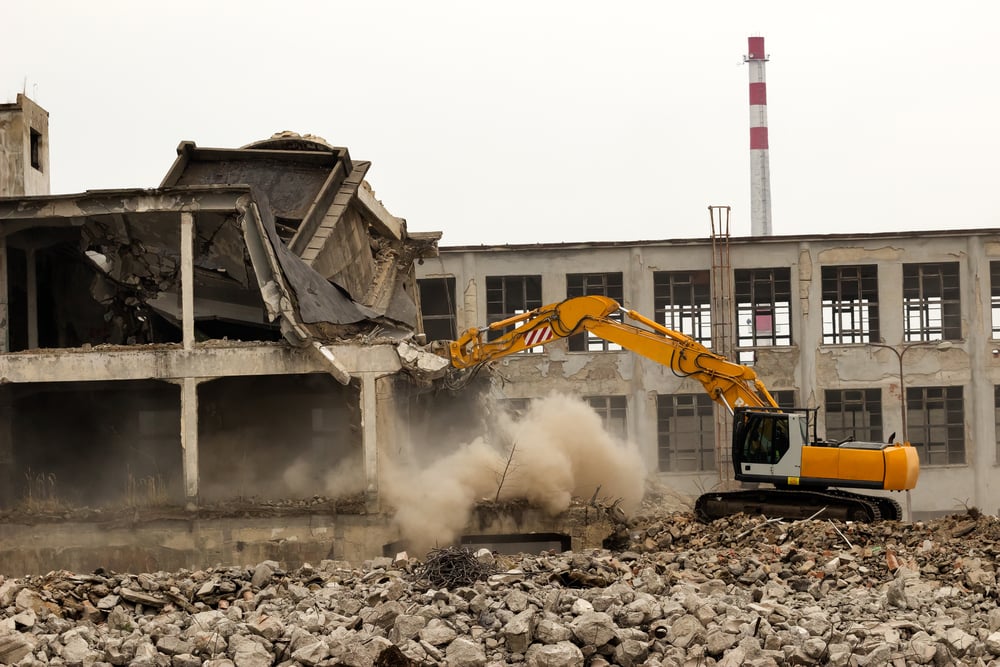Overview of Concrete Demolition Methods

Concrete structures may require maintenance such as patching or resurfacing in order to fix superficial cracks or erosion. However, when the surface is too damaged, these short-term fixes are a waste of money and time. In these cases, the surface will quickly display the same characteristics of the concrete underneath.
Here is a list of conditions in which a complete replacement of concrete is recommended:
- Sunken Concrete Slabs: Concrete slabs may sink when the subgrade was not properly prepared. Loose dirt may have been used for the subgrade, and this dirt can settle due to water leaking under the concrete. This causes the concrete slab to be unsupported and susceptible to sinking. Another possibility is that the subgrade was properly compacted, but the concrete slab was overloaded, which caused sinking.
- Frost Heave Damage: In cold climates, frost heave damage can occur easily on concrete slabs. Frost heave is the uplift of soil or other surface, due to expansion of groundwater when it freezes.
- Deep Cracks: Some concrete elements may display deep and widespread cracks in places where settlement has occurred. This can occur due to heavy loads such as large trucks, improper subgrade, erosion or similar reasons.
- Severely Damaged Concrete Surfaces: There are concrete slabs that display too much spalling or pitting on the surface. It is more economical to replace the entire concrete rather than repairing the surface.
- Construction Additions: When a structure will be modified of retrofitted, concrete elements that interfere with the project must be removed.
- New Construction: Some structures are demolished when a new building with a completely different purpose or architectural design is planned.
- Faulty Concrete: If a concrete batch has an issue that affects project quality, it must be removed and poured again.
Concrete Demolition Methods
The main methods used to demolish concrete are summarized below.
Streamline Your Construction Project with Expert Design and Planning Support!
Pressure Bursting
Pressure bursting is the best option in situations where a dust-free, controlled and relatively quiet concrete removal is required. Pressure bursting can be mechanical or chemical: in both cases, holes are drilled into the concrete and lateral forces are applied.
- In mechanical bursting, the concrete is split with a hydraulic pressure machine.
- In chemical bursting, concrete is split through the insertion of an expansive slurry.
- Once split, the concrete is removed by hand or with a crane.
Pneumatic and Hydraulic Breakers

This method is typically used in demolition projects involving foundations, pavements and bridge decks. The complexity of this method will depend on the strength of the concrete, the amount of steel reinforcement, the hammer size and working conditions.
Machine-mounted breakers can perform demolitions in a range of 100 to 20,000 foot-pounds at 300 to 800 blows per minute. These breakers can be controlled remotely and they use a telescoping boom for easy reach. Some are even designed for underwater demolition.
Ball and Crane Method
This is one of the oldest and most common demolition methods, where a crane uses a 13,500-pound wrecking ball to demolish concrete structures. The ball is dropped or swung into the structure, and only highly-skilled operators should perform ball and crane demolitions.
Concrete can be easily broken down with this method, but additional work may be required to cut steel reinforcement. Also consider that this method produces plenty of dust, noise and vibration. The size of the building that can be demolished depends of the size of the crane, the working area available, and the proximity of power lines.
Dismantling
Concrete elements can be cut using a saw, thermal lance (in the presence of reinforcing steel) or high-speed water jets. Concrete pieces are then removed by crane, allowing the complete demolition of a structure with little noise and dust, and minimal impact on the surroundings. This method is beneficial when building portions such as slabs or walls are being removed.
Explosives

Explosives can be used to remove large volumes of concrete. They are inserted and detonated in a series of predefined boreholes, causing the structure to break into smaller pieces. This method is versatile and flexible, but the resulting blast and vibration can damage surrounding structures if not controlled. Among all demolition methods, explosives normally have the most stringent safety regulations.
Conclusion
Concrete demolition is necessary in many situations, such as major renovation projects or when the material is damaged beyond repair. There are many methods available, each with advantages and disadvantages, and the best option will depend on the project’s needs and surroundings.
Large amounts of waste are generated when concrete is demolished, and there are disposal costs and environmental impact. However, concrete recycling is viable in many projects, reducing waste while saving on new materials.

Anuj Srivastava
Anuj Srivastava is a principal partner at NY Engineers. He is known for his MEP franchise market knowledge. Anuj is currently leading a team of 100+ MEP/FP engineers and has successfully led over 1500 franchise projects in the US.
Join 15,000+ Fellow Architects and Contractors
Get expert engineering tips straight to your inbox. Subscribe to the NY Engineers Blog below.



